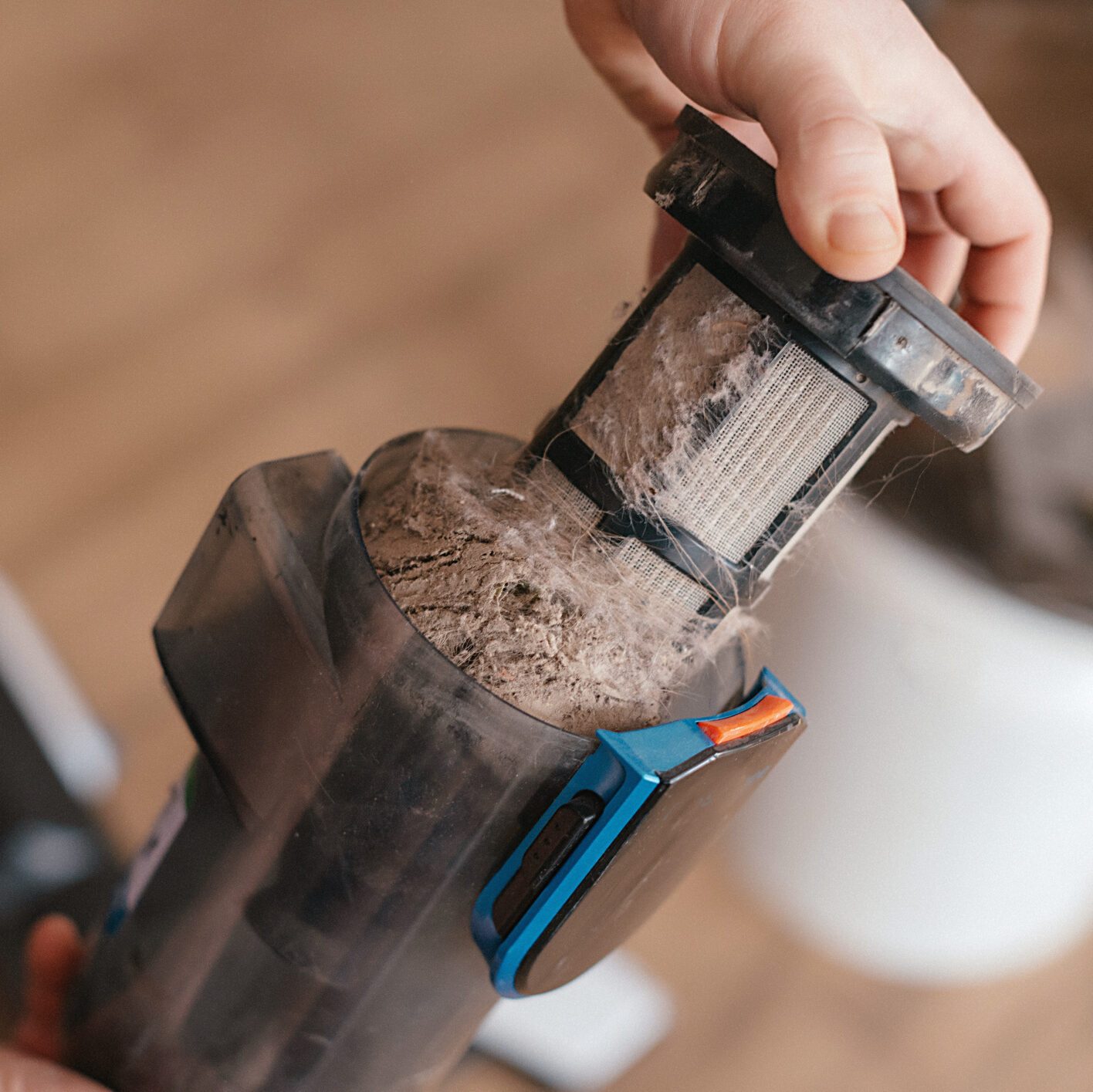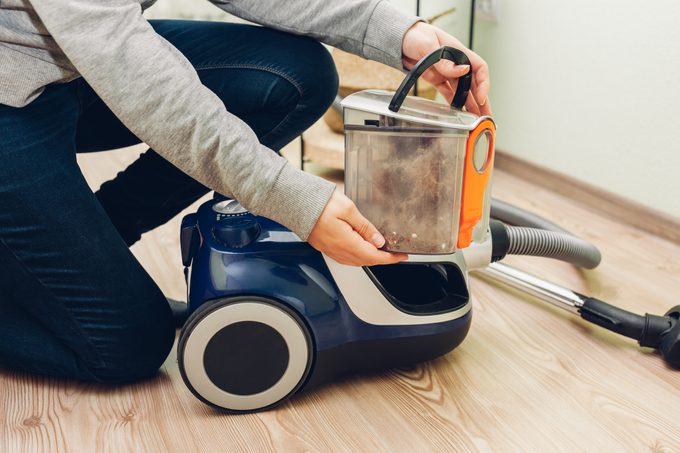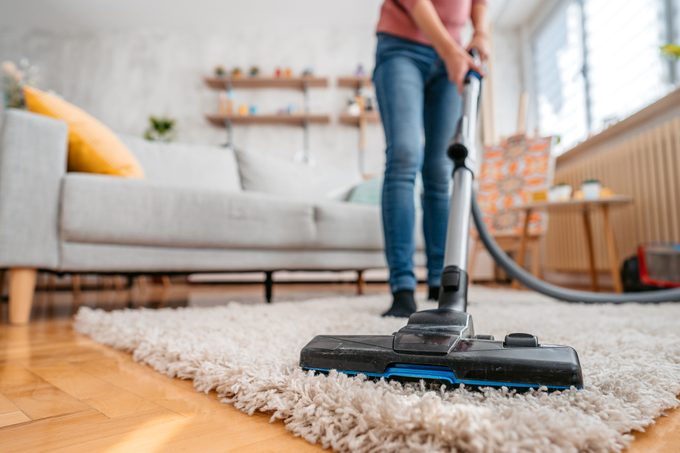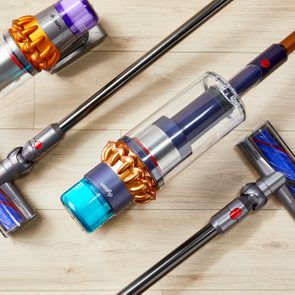It's a dirty job, and someone's got to do it … but hopefully not too often

Here’s How Long You Can Go Without Emptying Your Vacuum’s Canister

I don’t love vacuuming. If I can get away with using a broom or dust mop, I will. But I love a clean house, so when I do break out the vacuum cleaner, I get a bit of a thrill hearing all that dirt getting whisked up rat-a-tat-tat into the vacuum canister. Until it comes time to clean it out. That job is straight-up disgusting.
So I probably don’t clean out my vacuum canister as often as I should. What’s the right amount of time, anyway? (Spoiler alert: It’s not never.) But surely I can do a few rounds of vacuuming without emptying it, right?
To see if I’m derelict or ahead of the curve with my own habits, I checked in with cleaning expert Alicia Sokolowski, founder and co-CEO of AspenClean housecleaning services and eco-friendly products. Ahead, she’ll set us straight on how long we can plausibly go without emptying the vacuum canister.
Get Reader’s Digest’s Read Up newsletter for more humor, cleaning, travel, tech and fun facts all week long.
How much dirt does a vacuum canister hold?

It depends on the model, type and size of your vacuum, and it varies quite a bit. “Bagless canisters usually hold 1/2 to 3 liters,” Sokolowski says, with the smaller number more common on handheld models. Sometimes you’ll see the capacity listed in gallons, but liters is more common (1 liter is just over 1/4 gallon). For vacuum cleaners that have a disposable bag instead of a canister, Sokolowski says the capacity ranges from 2 to 6 liters.
We should stop here and mention that the term “canister vacuum” has a specific meaning, referring to those vacuums that have a pull-behind tank with a long flexible wand for sucking up dirt. On traditional upright vacuum cleaners like the one you probably have in your home, the container that holds the dirt, dust and hair is often called a “dust cup.” Here, we’ll use canister, container and dust cup interchangeably, since many people do so already.
Why is it important to empty your vacuum canister regularly?
In a word? Airflow. Without getting too far into the nitty-gritty technical details, vacuums work by creating a pressure differential between outside and inside the vacuum. Emptying the canister or swapping out the bag makes it easier for the vacuum to move air (and dirt) from your floor to the vacuum.
Here are the three main benefits of emptying your vacuum:
It improves suction
Who wants a vacuum that doesn’t suck? Nobody. Improved suction is the No. 1 reason you need to empty your vacuum or change the bag, Sokolowski says. Vacuums are all about the free flow of air, and when the dust cup, canister or bag is jammed with dirt and hair, the movement of air through the vacuum slows down considerably.
You’ve probably noticed that swapping out the bag or dumping the canister into the trash is kind of like getting a new vacuum cleaner, at least for a while. It’s not a coincidence. “Changing the vacuum bag or emptying the canister regularly helps maintain the strong suction power of your vacuum,” Sokolowski says. And, of course, that ensures that your carpet is cleaner.
It puts less strain on the motor
Unrestricted airflow also helps the motor run better and reduces wear and tear. “A full bag or canister can strain the motor, reducing the vacuum’s lifespan and efficiency,” Sokolowski says. As air flows into the vacuum cleaner, it serves a double purpose by cooling the motor as it cleans your home. A clogged bag or jam-packed canister and filter can cause overheating, eventually leading to a complete motor breakdown if it goes on for too long.
It improves air quality
One reason you vacuum your home is to keep the air you breathe healthy, right? Well, when your vacuum cleaner canister is full, the dust, pet dander and allergens in your carpeting and rugs don’t have anywhere to go—and worse, they get spewed up into the air as you run them over again and again trying to pick them up.
Sokolowski stresses that everyone benefits from a clean vacuum or fresh bag, but it’s especially important if you or someone in your family has a health concern like asthma or allergies, or if you live in a household with pets.
How long can you go without emptying the canister?
It depends on how often you vacuum and the dirt level of your household, but don’t let it go too long. For a bagless upright, the longest you should wait is however long it takes you to fill the canister to two-thirds capacity (which could be as little as a week or two if you have lots of grubby pets, like I do), while the outside limit for a bagged vacuum is three months, Sokolowski says.
Here are the factors to consider when deciding how long you can wait:
- Number of pets and how much they shed: “If you live in a household with pets, your vacuum bag or canister might require more frequent emptying,” Sokolowski says. According to her, that’s “usually weekly or after every use” for bagless, as pet hair and dander fill the canister very quickly. Bagged vacuums can generally last three months if you have no pets.
- Size of your home: If you have a big house or lots of deep-pile carpeting, Sokolowski suggests swapping out the bag or emptying the container more often—after every use for a bagless vac and once a month for bagged vacuums.
- Health issues: “If you suffer from allergies, you should empty or change the bag more frequently to reduce dust and allergens circulating back into your home,” Sokolowski says, so swap out the bag monthly or clean the dust cup after every use. “To improve your indoor air quality, you should also consider using HEPA filters.”
How often should you empty your vacuum canister, ideally?

Best practice is to empty the canister every time you run the vacuum, Sokolowski says. (Sorry! We know that’s probably not what you wanted to hear!) For vacuum cleaners with bags, shoot for every one to three months, depending on how often you vacuum and the amount of dirt collected.
“It’s best not to wait until the bag is completely full, as a bag that is two-thirds full can already reduce suction and potentially strain the motor,” she adds. Common signs that you need to change it include reduced suction power, a musty odor or visible dirt buildup near the bag opening. “Some vacuums also have a ‘bag full’ indicator light to let you know when it’s time for a replacement.”
Is it OK to wait till the canister is full before you empty it?
Not really. “You should empty the canister after every use, or when it reaches about 50% to 75% capacity,” Sokolowski says.
If you’re wondering who could possibly fill an entire canister vacuum during one vacuuming session, rest assured, it’s possible. Mine picks up so much pet hair sometimes that I have to stop midway through vacuuming my house to empty it.
The bottom line: Don’t wait. “Allowing it to overfill can clog filters, reduce airflow and cause dust to escape back into the air.”
How often should you clean other parts of your vacuum?
It depends. Your vacuum cleaner is a pretty simple machine, but it has multiple parts that work together to keep your home clean. And—you guessed it—they all need regular maintenance and cleaning at varying intervals.
“You should definitely clean the other parts of your vacuum, as regular maintenance ensures better performance,” Sokolowski says.
Here’s where to focus:
- Filters: Tap or shake removable foam filters outside to free them of embedded dust every time you empty your bagless dust canister. “Clean or replace them every three to six months, or more frequently with heavy use or pet hair,” Sokolowski says. You can clean washable filters by soaking them in warm soapy water, then rinsing them well. Make sure they are dry before reinstalling.
- Brush roll: Unplug your machine, then get to work on the brush on the bottom. “Remove tangled hair and debris every one to two months to prevent clogs,” Sokolowski says.
- Hoses and attachments: Check for clogs every few months or if you notice reduced suction. Wipe down hoses with a damp cloth or give them a good soak. For clogs, try running a broomstick through the hose or using a drain snake or a coat hanger to free stubborn, ratted hair or debris.
- Exterior: Wipe down the exterior as needed when you notice dust buildup.
About the expert
|
Why trust us
At Reader’s Digest, we’re committed to producing high-quality content by writers with expertise and experience in their field in consultation with relevant, qualified experts. We rely on reputable primary sources, including government and professional organizations and academic institutions as well as our writers’ personal experiences where appropriate. We verify all facts and data, back them with credible sourcing and revisit them over time to ensure they remain accurate and up to date. Read more about our team, our contributors and our editorial policies.
Sources:
- Alicia Sokolowski, founder and co-CEO of AspenClean; email interview, Mar. 5, 2025
- Building and Environment: “Impact of Vacuum Cleaning on Indoor Air Quality”























